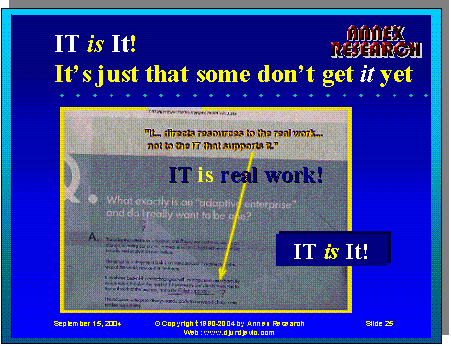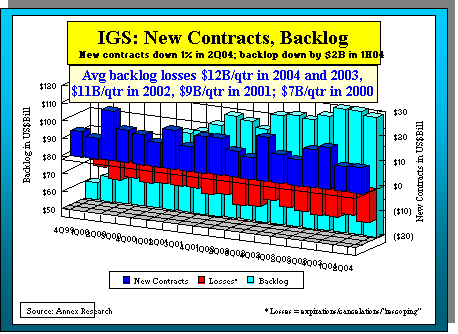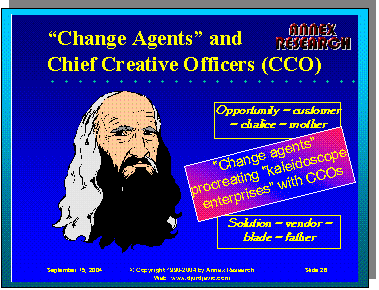
Home |
Headlines | Annex Bulletins
| Index 2004 | About
Founder | Search | Feedback
| Clips | Activism
| Client quotes | Workshop | Columns
| Subscribe ![]()
The copyright-protected information contained in the ANNEX BULLETINS and ANNEX NEWSFLASHES is part of the Comprehensive Market Service (CMS). It is intended for the exclusive use by those who have contracted for the entire CMS service.
An OPEN Client Edition
![]()
INDUSTRY TRENDS
An Annex Research Editorial: “OnDemand” Out of Fashion?
Outsourcing Boomerang
JP Morgan Kicks Out IBM; Outsourced Jobs Come Back Home – via India
PHOENIX, Sep 15
–Over 14 years ago, we predicted that outsourcing would become a global
rage, putting the IT services firms at the top of the industry’s food
chain (see Industry
Stratification Trend, Mar. 30, 1990).
It has.
Now, two news stories suggest a possible
reversal of that trend. This morning, JP Morgan kicked out IBM saying it
could do better in-house, just over a year into a much-ballyhooed
$5 billion seven-year outsourcing contract.
Amazingly, IBM agreed, saying the megadeal’s cancellation would
actually help (!) Big Blue’s 2005 earnings per share. Is OnDemand now out of fashion?
morning, JP Morgan kicked out IBM saying it
could do better in-house, just over a year into a much-ballyhooed
$5 billion seven-year outsourcing contract.
Amazingly, IBM agreed, saying the megadeal’s cancellation would
actually help (!) Big Blue’s 2005 earnings per share. Is OnDemand now out of fashion?
Meanwhile, the news from India is that a
different kind of an outsourcing boomerang may be under way.
Several Indian IT services firms are setting up shops overseas,
including at least one in the U.S. That could help George W. Bush fight off charges by John Kerry
that he is outsourcing American jobs overseas.
Alas, both candidates are too busy slinging mud at each other to
notice little news gems like this Sep 2 Reuters story.
JP
Morgan Kicks Out IBM
At the time the JP Morgan outsourcing deal was announced (in December 2002), IBM hailed it as its biggest and most important outsourcing contract ever (see the quote from AtNewYork.com in the footnote[1]). Most important, because it supposedly validated IBM’s (then new) OnDemand concept. We said last year, however, that OnDemand was merely “a new name for an old concept” – see “Different Strokes for Different Folks,” Dec 2003).
Now, JP Morgan, the
No. 2 U.S. bank following its recent merger with Bank One, has confirmed
that. The company said it
“could better manage its own technology and infrastructure.”
And it will rehire about 4,000 workers it had outsourced to IBM.
So much for the customer “concentrating on its core business,” a familiar refrain of IT services vendors’ sales pitches. With IT nowadays being inextricable interwoven into nearly every fabric of corporate endeavors, there is clearly no such thing anymore as “core business” outside of IT. “IT is IT” should be the IT services’ industry slogan, we suggested in a March executive workshop (see the slide-chart).

We also said in our January
“Holy Grail” editorial “Whither
Goeth It, IT?”, that outsourcing per se is an obsolete term:
“Outsourcing,”
for example, should be abandoned as an outdated type of business
relationship. Outsourcing
implies that the customer turns over the responsibility for running its IT
to a vendor, and then just yells at him if something goes wrong.
As a parent of a new “adaptive enterprise,” the customer
(mother) has a joint custody of the infant with the vendor
(father). Both are
responsible for its well-being. Both should share in risks and benefits of its upbringing.
(An excerpt “Whither
Goeth It, IT?”, Jan 2004)
Evidently, both JP Morgan and IBM were unhappy
parents of an unwanted child. The
fact that IBM said the megadeal’s cancellation would help its earnings
speaks volumes about how unprofitable the deal must have been.
No surprise there. As we’ve said many times before, megadeals are like a game
of chicken. The last vendor
to say no to the deal gets stuck with it.
Nor is this the only sad case in IBM’s backlog; only the most visible so far. As we have been also pointing out for several years now, IBM has been losing about $12 billion from its backlog each quarter during 2003 and 2004 to-date. Compare that to about $7 billion per quarter that Big Blue’s new contracts “black hole” swallowed up in 2000, for example, and even less than that in prior years (see the chart).

IBM also said today, in the
aftermath of the JP Morgan deal collapse, that its backlog of services
would be revised (presumably downward) when it announces its third-quarter
earnings next month. As it
turns out, the IBM backlog was already down by $2 billion even before the
loss of this megadeal (see the “Old
World” Renaissance, July 2004).
IGS (IBM Global
Services) is losing more business than it is
winning.
That’s why its backlog has shrunk.
That’s what’s worrisome about IGS’ future.
(from Annex
Bulletin 2004-15, July 2004)
So the only question to be answered in October
will be how much more will the JP Morgan deal take out of the IBM backlog.
An
Indian Boomerang
Last February, and again last month, we
pointed out two corporate examples of “A Passage FROM India” taking
place [A
Passage from
India (HP) and Unbreakable
Spirit – (Oracle)].
Now, a September 2 Reuters report has
highlighted another one. “The
next back-office job that goes to an Indian outsourcing company may not be
moving as far as you think,” Reuters said in a report filed from Bombay.
“In a bid to tap new markets and satisfy customers keen to
outsource to more than one location, India's back-office service providers
are setting up shop overseas.”
Infosys Technologies' backoffice subsidiary
Progeon has opened a center in the Czech Republic, while MphasiS BFL's arm
MSourcE has a contact center in Mexico.
Daksh eServices, recently acquired by IBM, and Hinduja TMT also
have operations in the Philippines. WNS
Global Services, India's largest independent backoffice services firm, is
opening a center in neighboring Sri Lanka, while ICICI OneSource, an
outsourcing firm majority owned by India's ICICI Bank and one of its
subsidiaries, has announced the purchase of a Chicago-based business on
Wednesday (Sep 1).
So it seems that
the American jobs outsourcing has come a full circle. As the Indian firms are growing and making more money from
the original American investments, they are becoming more ambitious and
more aggressive globally. A
result is an outsourcing jobs rebound, however embryonic the trend may
still be at the moment.
Cracking
Language Barriers and Smiles
Some of the new centers being set up overseas
by Indian firms are due to language barriers.
So the Spanish-speaking customers are better served out of Mexico
than Mumbai. But sometimes
even the famed Indian support staff's English language prowess may be a
bit of an oversell.
Just yesterday, for example, this writer
corresponded with a Microsoft tech rep at its support center in Mumbai,
India. Our Windows XP was
slow, and we asked for help.
“Would you like me to show you how to fast
your PC?” the Indian tech rep asked in an IM message.
To which this writer replied: “Sure.
As long as it doesn’t starve it to death.”
J
India:
Hungary, Israel of 1980s
The need to find skilled workers is another
attraction of overseas locations. Nearly
half the workers in some Indian outsourcing companies change their jobs or
leave the industry every year. Quality
suffers as firms focus more on recruitment than on training.
Talented youngsters often leave the industry
in frustration. Companies who
hired aspiring, English-speaking 20-something workers have found that
these employees are hard to keep. With
such challenges at home, Indian firms choose look for talent in other
countries, Reuters said.
Welcome to Hungary and Israel of the 1980s!
(see A
Passage to India, July 2003).
Hungary
and Israel, for example, used to be the "India's of the 1980s."
Remember the "goulash communism," a term coined for Hungary's
newfound "capitalism," while this country was still under the
Soviet yoke?
As the
once cheap labor force got richer, however, the Hungarian and Israeli
programmers, among others, discovered that the grass is greener on
the other side of the fence - in the West.
So many skilled software developers upped and left their home
countries in pursuit of higher salaries in America and Western Europe.
(from Annex
Newsflash 2003-09, July 22, 2003)
What goes around comes
around. So it seems with
outsourcing and Happy
bargain hunting! Bob
Djurdjevic IBM’s OnDemand.
Once alleged trend-setting concepts are now suffering boomerang
effects of their former successes. Boy
oh boy… that Leonardo da Vinci look-alike, the Chief Creative Officer,
is looking more and more real all the time (see “Whither
Goeth It, IT?”).
IBM’s OnDemand.
Once alleged trend-setting concepts are now suffering boomerang
effects of their former successes. Boy
oh boy… that Leonardo da Vinci look-alike, the Chief Creative Officer,
is looking more and more real all the time (see “Whither
Goeth It, IT?”).
[1]
JP Morgan Chase has
finalized its largest-ever contract, a seven-year outsourcing
agreement with IBM worth in excess of $5 billion, the
commercial/investment bank announced Monday. The deal also ranks as
IBM's largest outsourcing agreement, eclipsing its seven-year, $4
billion outsourcing arrangement with American Express.
Perhaps more important for IBM, the contract with JP Morgan Chase is among its first major outsourcing contracts that deploy new "on-demand" services, part of IBM's much-ballyhooed strategy of providing "pay as you go" computing services and IT infrastructure to corporate customers. (from AtNewYork.com, Dec 30, 2002).
![]()
For additional Annex Research reports, check out...
2004: Outsourcing Boomerang (Sep 2004); EDS to Cut Up to 20,000 More Jobs (Sep 2004); Capgemini Stock Plummets on Unexpected Loss (Sep 2004) HP Savaged by Wall Street (Aug 2004); Moody's Lowers the Boon on EDS (July 2004); HP: Delivering Value Horizontally (June 2004); Accenture: Revving Up a Notch (June 2004); Beware Your CFO! (May 2004); IBM: Changing of the Guard (May 2004); Capgemini: Texas-size Home Run (May 2004); Following the Money (May 2004); EDS: On a Wink and a Prayer (Apr 2004); HPS Wins by a Nose! (Octathlon 2004); Accenture: Burning the Track (Mar 2004); IGS: "Crown Jewel" Restored? (Mar 2004); HP: Still No Cigar (Feb 2004); Cap Gemini: Another, Smaller Loss (Feb 2004); CSC: Good Quarter Gets Boos (Feb 2004); EDS: "Hot Air Jordan" Flaunts Flop as Feat (Feb 2004); IT Industry: Whither Goeth It? (Jan 2004); Cronyism Is Alive and Well at EDS" (Jan 2004)
2003 IGS: "IBM OnDemand: Different Strokes for Different Folks" (Dec 2003); "Investing in Growth" (Apr 2003)
2003 IBM: "IBM vs. HP: Spinning Global Server Market Shares" (Nov 2003); "Finally Heard, Part II," (Nov 2003), “Small Is Now Big at Big Blue” (Oct 16), “On the Nose But No Cigar” (July 16), “A Paler Shade of Blue” (June 2), “Save, Spend and Split” (May 8), “Shrunk by the Marketplace” (Apr 17), “Turnaround Continues...” (Apr 15), "Finally Heard!" (Jan 29), “Start of a Real Turnaround?” (Jan 17).
2002 IGS: "Half or Double Trouble?" (Aug. 12, 2002), "IBM to Take $500M Charge" (Sep 3, 2002), IBM-PwCC Update (Oct 2, 2002), Analysis of IBM Second Quarter Results (July 17, 2002), IBM Layoffs Confirmed! (Aug 14, 2002), Analysis of IBM Third Quarter Results (Oct 16, 2002), Boom Amid Gloom and Doom (Oct 10, 2002)
2002 IBM: “Gerstner: The Untold Story” (Dec 27), "Gerstner Spills the Beans" (Dec 13), "On a Wing and a Prayer" (Oct 21), "IBM-PwC Tie the Knot" (Oct 2), Big Blue Salami (June 19), "Looming IBM Layoffs" (May 14), "IBM 5-Yr Forecast: From Here to Eternity?" (Apr 2002), “Tough Times, Soft Deals,” (Apr 25, 2002), “Gerstner’s Legacy: Good Manager, Poor Entrepreneur” (Jan 2002), IBM Pension Plan Vapors: Where Did $17 Billion Go? (Mar 2002), "Sir Lou OutLayed Lay!" (Apr 1, 2002).
A selection from prior years: Is IBM Cheating on Taxes, Annex Bulletin 99-17 (May 1999), IBM 5-year Forecast 2001: An Unenviable Legacy (June 2001), "Break Up IBM!" (Mar. 1996), Fortune on IBM (June 15, 2000), “Smoke and Mirrors Galore,” July 2000), "Slam Dunk of Bunk" (Jan 2000), Annex Bulletin 98-14 ("Wag the Big Blue Dog"), Armonk's Fudge Factory (Apr. 9, 1999), Where Armonk Meets Wall Street, Greed Breeds Incest (November 1998), Stock Buybacks Questioned: Is IBM Mortgaging Its Future Again?, 97-18 (4/29/97), "Some Insiders Cashed In On IBM Stock's Rise, Buybacks" 97-22, 7/27/97, Djurdjevic’s Forbes column, "Is Big Blue Back?," 6/10/97; “Executive Suite: How Sweet!,” (July 1997), "Gerstner: Best Years Are Behind", Aug. 10, 1999), "IBM's Best Years Are 3-4 Decades Behind Us" (July 1999), "Lou's Lair vs. Bill's Loft" (June 1999), "Corporate Cabbage Patch Dolls," 98-39, 10/31/98; Djurdjevic’s Chronicles magazine October 1998 column, "Wall Street Boom; Main Street Doom", “Louis XIX of Armonk,” (Aug. 1996), "Mountain Shook, Mouse Was Born" (Mar. 25, 1994), “A Nice Guy Who Lost His Compass” (Jan 26, 1993), “Akers: The Last Emperor?” June 1991), Industry Stratification Trend (Mar. 30, 1990), etc.]
![]()
Or just click on  and use appropriate
keywords.
and use appropriate
keywords.
Volume XX, Annex Bulletin 2004-19 Bob Djurdjevic, Editor 4440 E Camelback Rd #29, Phoenix, Arizona 85018 |
![]()
Home | Headlines | Annex Bulletins | Index 2004 | About Founder | Search | Feedback | Clips | Activism | Client quotes | Workshop | Columns | Subscribe